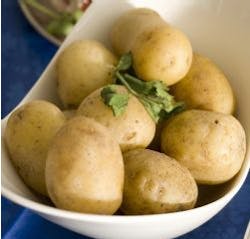Potato industry reaps benefits of computer vision
A prototype computer vision system that can identify sub-standard potatoes has been developed by computer scientists from the University of Lincoln (Lincoln, UK).
Today, most potatoes are sorted into different grades by hand, often resulting in mistakes. Now, working with the UK Potato Council, the University of Lincoln team from the Centre for Vision and Robotics Research has produced a low-cost system that uses off-the-shelf hardware and bespoke software to detect, identify and quantify common defects affecting potatoes.
Director of the Centre for Vision and Robotics Research Dr. Tom Duckett says, “The system relies on initial input by an expert, identifying blemishes, diseases, as well as good specimens, from sample batches of potatoes. The system can be trained to recognise different defect types and will analyse potatoes in near-real-time – a significant improvement on previous research in this area.”
The system developed uses off-the-shelf hardware, including a USB HD web camera costing around £70. Dr. Duckett said that he would expect even better results with an expensive machine vision sensor, but a low-cost web camera was chosen to demonstrate the robustness of the system’s learning capabilities and that it could potentially work with any reasonable choice of sensor.
Once captured, the images of the potatoes are processed on a high-end desktop PC equipped with a Quad Core processor and a Graphics Processing Unit (GPU) for accelerating some of the core image processing functions. This runs the software algorithms that enable the common defects to be detected, identified and quantified.
Dr. Duckett said that the system is trained from a sample of potato images marked up by a human expert, such as the quality control (QC) staff working in the industry. The system output includes a breakdown of the blemish types detected together with an estimate of the corresponding levels of surface area of the potato that is affected.
“Most people will be familiar with the fact that potatoes tend to go green when exposed to light, a blemish known (unsurprisingly) as “greening”. However, for white potato varieties, greening tends to look green, whereas for red potato varieties, greening tends to look more black than green. Hence it is not possible to design a “one size fits all” approach for visual inspection of fresh produce such as potatoes, and why we opted for a trainable approach,” says Dr. Duckett.
As well as speeding up the system to work in real-time (30 frames per second), the researchers developed an easy-to-use graphical user interface (GUI) to enable interactive training of the system.
Post-graduate students from the Centre for Vision and Robotics Research played a major role in the project with Michael Barnes (a PhD student) undertaking underpinning theoretic research, while Jamie Hutton (an MSc student) was responsible for researching and developing the real-time prototype for industry testing.
The team worked with Glyn Harper from Sutton Bridge Crop Storage Research - the leading post-harvest applied research facility for agricultural storage in the UK. It is owned by the Agriculture & Horticulture Development Board and operated by its Potato Council division.
-- by Dave Wilson, Senior Editor, Vision Systems Design
